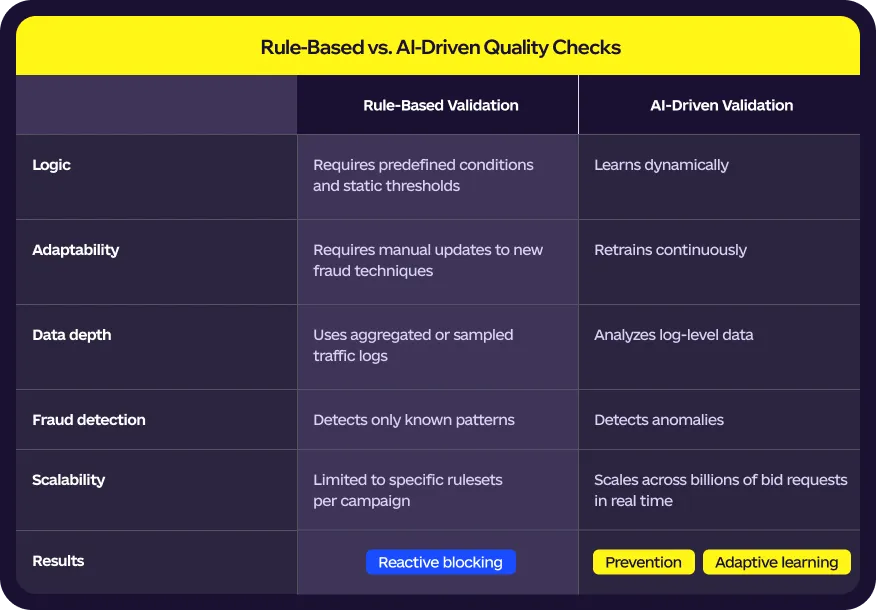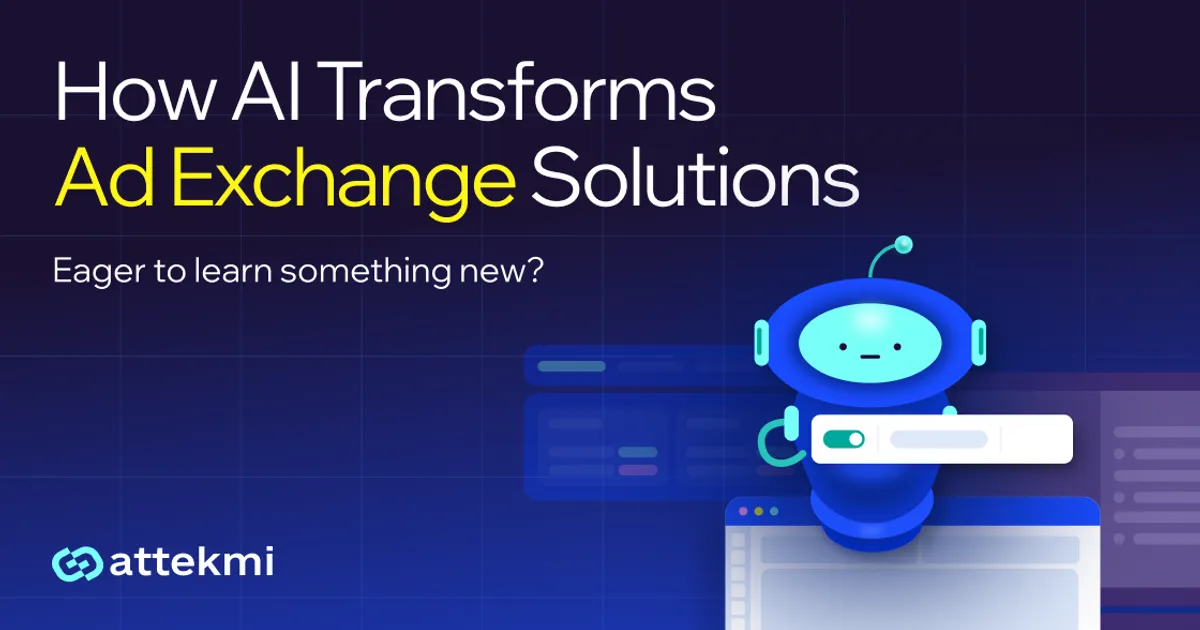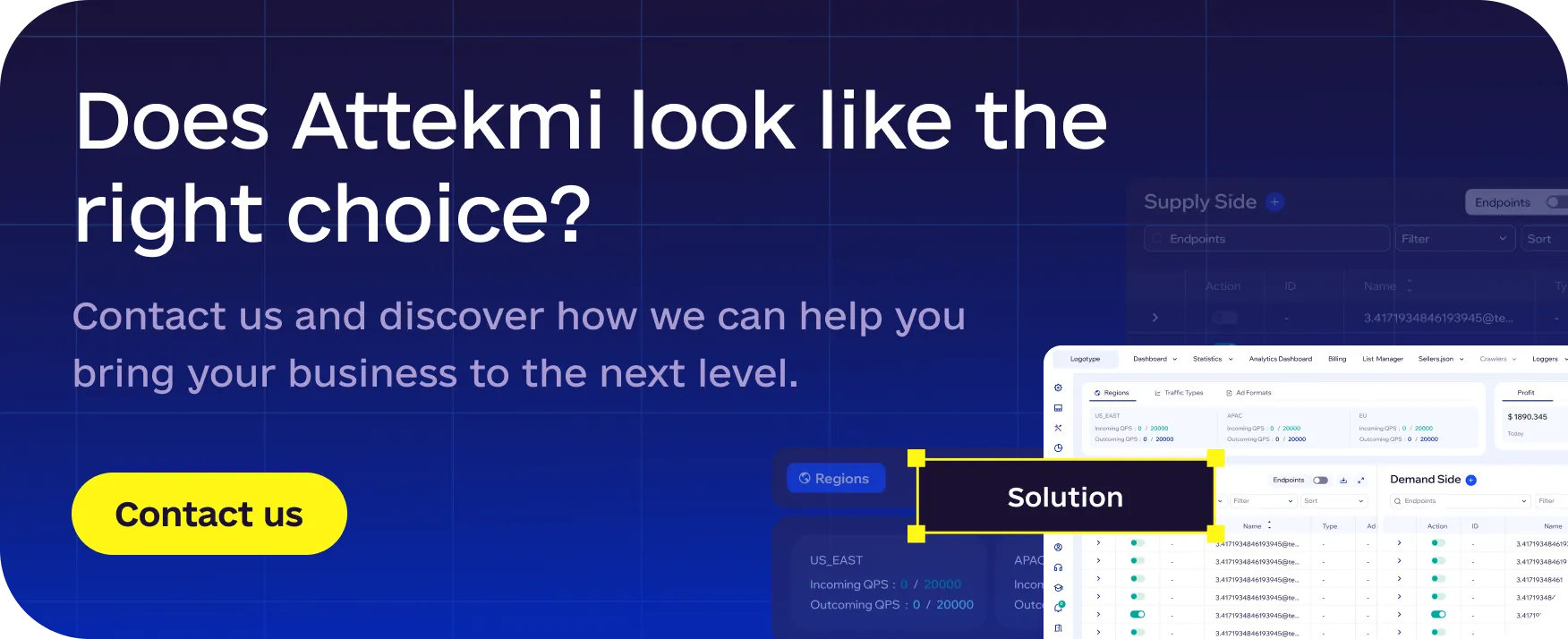Manual or rule-based optimization worked well when advertising campaigns were simpler. However, the modern AdTech ecosystem is too complex, data-heavy, and dynamic, so that approach is no longer effective.
Programmatic advertising works at an enormous scale and requires real-time learning. These are the factors and tasks AI can perfectly deal with, as well as with traffic validation, real-time decisioning, etc. Besides, AI helps improve programmatic transparency and increase the overall efficiency of the campaigns.
AI is widely used in diverse AdTech solutions, but what about the role of artificial intelligence in advertising exchanges? This guide is here to answer this question, so keep reading to discover the key benefits and applications of AI.
Key Takeaways:
AI in ad exchanges helps ensure traffic quality and prevent fraud, which is a crucial task in modern AdTech systems.
Thanks to predictive capabilities, AI can optimize the real-time bidding process and improve the overall platform performance.
Dynamic floor pricing and yield management driven by AI allow ad exchange owners to deliver an ultimate experience to their clients.
With AI, ad exchange owners can predict opportunities in advance and adjust their strategies accordingly.
Transparency and explainability remain among the key aspects to pay attention to.
Traffic quality as the foundation of exchange performance
Low-quality or invalid traffic can significantly affect bid outcomes. When advertisers bid on impressions that are not genuine, they waste their budgets, and the performance metrics are not accurate. For ad exchange owners, this implies decreased income and potential loss of trust. Since fraudulent techniques are evolving continuously, rule-based filters cannot guarantee traffic quality anymore.
This is where AI-driven fraud prevention and real-time anomaly detection come in. By analyzing log-level data, AI models evaluate each bid request in real time. Machine learning systems continuously learn what “normal” traffic looks like and detect issues without human intervention.

AI-powered fraud detection and invalid traffic prevention
In AI-powered ad exchanges, systems do not rely on static filters. Instead, they analyze millions of signals in real time and learn to recognize non-human behavior. Fraud prevention algorithms are trained on verified examples of both human and fraudulent activity, so they can classify bid requests accurately. In addition, real-time scoring algorithms assign a dynamic risk score to each impression as soon as it appears in the exchange.
Over time, the AI-driven approach can significantly improve the platform’s efficiency. For instance, it can reduce false positives that may block valid impressions. While your partners will benefit from enhanced performance, you will see an increase in income.
Real-time bidding optimization with AI
Predictive algorithms enable AI-driven ad exchange platforms to make smarter, faster decisions regarding bid price, impression value, and fill rate. Conducting bid stream analysis, the models continuously evaluate auction dynamics (for instance, user intent and contextual relevance) and determine the most cost-effective bid. This happens within milliseconds, which ensures latency reduction. Many systems use reinforcement learning to refine strategies over time. With such a reinforcement learning loop, each auction outcome trains the model to balance campaign goals with budget limitations. You, as an ad exchange owner, deliver a greater experience to your partners, while your income grows thanks to AI contributions.

Dynamic floor pricing and yield management
AI in advertising exchanges allows for precise floor price optimization and yield management. The models continuously adjust floor prices according to live auction data and other inputs like, for instance, CTR trends, ad format performance, changes in seasonal demand, device mix, and others. Considering these and other factors, the system keeps bids optimal and reduces the risk of underpricing.
Apart from this, artificial intelligence in ad exchanges can detect when impressions of higher value appear, for instance, within specific time slots, and automatically adjust floors to ensure maximum yield. In general, such an adaptive bidding engine usually results in higher eCPM rates due to more effective bid alignment between advertisers and media owners. Again, for you, this means greater income.
Predictive analytics and demand forecasting
AI-powered predictive analytics enables AdTech platforms to project changes in bid density, audience demand, and inventory performance with much greater precision than in comparison with other forecasting methods. By utilizing historical auction data, user engagement metrics, and diverse variables like, for instance, time of day or device type, the systems identify emerging patterns before they actually take place. This way, you can optimize your strategy in advance and seize the opportunity to enhance the performance of your platform.
Here is a brief example – cross-platform inventory forecasting. AI models consolidate data from various channels (e.g., web and mobile) to predict ad inventory availability and demand shifts across platforms. Let’s say, the prediction may be as follows: a 35% rise in CTV bid density due to live events and an 18% increase in mobile app impressions due to seasonal usage. With these insights in mind, a business can adjust its budget and pricing strategy in advance. Other examples may include predictive floor pricing, yield prediction models, etc.
AI in programmatic ad exchanges supports data-driven decision-making, which allows companies to achieve better results in a streamlined way. However, do not accept every prediction blindly – review every suggestion thoroughly.
Transparency and explainability in AI models
Ad exchanges using artificial intelligence imply enhanced bid request validation, fraud detection, decision-tree scoring, and other benefits. However, since the usage of AI is growing, the need for model interpretability increases as well, with transparency and explainability as the main aspects.
In the AdTech context, explainability means the ability to interpret how AI algorithms determine bid outcomes, pricing decisions, or traffic quality classifications. This is essential to ensure that automated logic remains auditable and free from hidden bias. Regular algorithmic audits and bias detection protocols help align AI-driven decisions with both regulatory frameworks (like, for instance, GDPR or CCPA) and industry best practices.
By making AI and machine learning in ad exchanges more interpretable, AdTech providers increase buyer confidence and, therefore, enable advertisers to understand why certain bids win or lose and how value is defined. Remember, transparency is not only about compliance – it allows for building a trusted ecosystem where automation is a benefit, not an issue.
How Attekmi applies AI in ad exchanges
Building an advanced ad exchange solution from the ground up can take months and even years. Besides, such a process requires significant investments. Fortunately, Attekmi is here to help you join the AdTech ecosystem in the shortest time possible and with minimum expenses. We offer a selection of ad exchange solutions that is able to meet any needs:
AdEx Basic: An entry-level platform with basic capabilities. A perfect choice for those only entering the industry.
AdEx Plus: An enhanced version of AdEx Basic. For those businesses that require additional functionalities.
AdEx Enterprise: A platform with advanced functionality and an ultimately scalable nature. For brands that plan to scale their operations across different regions in a smooth and effective manner.
White Label Ad Exchange: A fully customizable solution, from UI personalization to custom on-request feature development. For businesses that want to conquer the AdTech industry on their own terms.
To help you make the most of your solution, we leverage AI for ad exchange automation. Thus, the traffic throttling mechanism analyzes various performance-based metrics for each demand-side endpoint to define the preferred traffic. Then, the system automatically increases the volume of relevant traffic for every demand partner, prioritizing the traffic that demonstrates the highest conversion into spend. This is beneficial not only for the demand side – AI helps you to increase media trading income.
Another AI-driven functionality, adaptive margin, helps you maximize your income as well. You can activate it for both demand and supply-side partners. When the adaptive margin is enabled, it automatically calculates the most optimal margin – this is done according to recommended markups taken from the most successful trades that happened within 24 hours. The adaptive margin operates on the basis of a self-learning mechanism that considers both data analysis and calculation of the optimal margin for different ad formats and traffic types.
With the adaptive margin functionality, StreamKey achieved 1637% ROI and doubled the revenue.
In addition, since we are your trusted partner in any AdTech matter, we offer the following services:
Custom AdTech development: We are ready to bring your unique project to life. Just communicate your requirements to us, and our team will create a solution fully tailored to your needs.
Ad Ops outstaffing: We can train an expert specifically for your company. You will be able to focus on your core business tasks while your operations run smoothly.
AdTech and Ad Ops training: We can help you master new skills and gain knowledge.
Thus, with our outstaffing services, Toucan Ads achieved 372% ROI and 576% revenue growth. Explore more case studies to discover the ultimate efficiency of our ad exchanges solutions and AdTech and Ad Ops services.
Conclusion
Automated supply path optimization, enhanced fraud detection and prevention, real-time bidding optimization, dynamic floor pricing, and streamlined data normalization pipeline – these are just some of the capabilities introduced by AI in advertising exchanges. Moreover, the technology keeps evolving, so we can expect even more benefits and opportunities.
However, it is crucial to remember that AI requires human oversight. That is a powerful tool, but the models must be trained properly, while the performance of your ad exchange solution should be monitored continuously. This way, by combining AI capabilities with your own expertise and skills, you can make the most of your solution and ensure its profitability and competitiveness.
FAQ
AI in ad exchanges detects invalid traffic by analyzing behavioral, technical, and other patterns in real time (e.g., user interaction depth). It identifies anomalies, filters bot-generated or spoofed requests, and continuously retrains on new data to adapt to evolving fraud tactics.
Sure. AI in programmatic ad exchanges improves transparency by analyzing log-level data to identify each bid’s path, verify pricing, and detect hidden fees or intermediaries. AI clarifies why bids win or lose, helping understand auction logic, ensure regulatory compliance, and build trust.
AI needs real-time auction data (e.g., bid requests, floor prices, win rates, and latency), user and context signals (device, location, time, etc.), and historical performance metrics (like CTR, conversion rate, and eCPM). By combining these inputs, AI immediately predicts impression value and adjusts bids to maximize ROI.
 By Anastasiia Lushyna
By Anastasiia Lushyna
